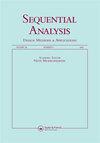为支持均匀分布而获得覆盖所需的观测数的分布
IF 0.6
4区 数学
Q4 STATISTICS & PROBABILITY
Sequential Analysis-Design Methods and Applications
Pub Date : 2023-09-20
DOI:10.1080/07474946.2023.2242414
引用次数: 0
摘要
摘要对于给定的正数“δ”,我们从U(0,1)分布中考虑独立同分布(i.i.d)随机变量的δ -邻域序列,并且“当它们的并集包含区间(0,1)时就停止”。我们称这样的联盟为“掩护”。为了求出停止时间随机变量N(δ)的分布,我们需要U(0,1)分布的阶统计量的联合分布。对于每个δ>0且n=1,2,…,我们得到了P(n (δ)≤n)的一般表达式,对于固定值的δ,它是n (δ)的分布函数。对于给定的n,设Δ(n)为Δ的最小值,使得前n个观测值的n个Δ−邻域的并集包含区间(0,1)。因为N(δ)≤N当且仅当Δ(N)≤δ,所以将N固定在P(N(δ)≤N)的一般表达式中,即可得到Δ(N)的分布。为了描述δ对N(δ)和N对Δ(N)分布的影响,我们绘制了分布函数图和经验分布函数图。关键词:邻域停止规则均匀分布主题分类:MSC 2020: 26B1562E15感谢S. B. Patil和S. R. Rattihalli的计算协助。作者无利益冲突需要报告。本文章由计算机程序翻译,如有差异,请以英文原文为准。
Distribution of number of observations required to obtain a cover for the support of a uniform distribution
AbstractFor a given positive number ‘δ′, we consider a sequence of δ− neighborhoods of the independent and identically distributed (i.i.d.) random variables, from a U(0,1) distribution, and “stop as soon as their union contains the interval (0,1).” We call such a union “a cover.” To find the distributions of N(δ), the stopping time random variable, we need the joint distribution of order statistics from a U(0,1) distribution. For each δ>0 and n=1,2,…, we obtain a general expression for P(N(δ)≤n), and for a fixed value of δ, it is the distribution function of N(δ). For a given n, let Δ(n) be the minimum value of δ, so that the union of the n δ− neighborhoods of the first n observations contains the interval (0,1). Because N(δ)≤n if and only if Δ(n)≤δ, the distributions of Δ(n) can be obtained by fixing n in the general expression for P(N(δ)≤n). To describe the impact of δ on the distribution of N(δ) and that of n on Δ(n), we sketch the graphs of distribution functions and the empirical distribution functions.Keywords: Neighborhoodstopping ruleuniform distributionSubject Classification: MSC 2020: 26B1562E15 ACKNOWLEDGMENTThanks to S. B. Patil and S. R. Rattihalli for their computational assistance.DISCLOSUREThe author has no conflicts of interest to report.
求助全文
通过发布文献求助,成功后即可免费获取论文全文。
去求助
来源期刊

Sequential Analysis-Design Methods and Applications
STATISTICS & PROBABILITY-
CiteScore
1.40
自引率
12.50%
发文量
20
期刊介绍:
The purpose of Sequential Analysis is to contribute to theoretical and applied aspects of sequential methodologies in all areas of statistical science. Published papers highlight the development of new and important sequential approaches.
Interdisciplinary articles that emphasize the methodology of practical value to applied researchers and statistical consultants are highly encouraged. Papers that cover contemporary areas of applications including animal abundance, bioequivalence, communication science, computer simulations, data mining, directional data, disease mapping, environmental sampling, genome, imaging, microarrays, networking, parallel processing, pest management, sonar detection, spatial statistics, tracking, and engineering are deemed especially important. Of particular value are expository review articles that critically synthesize broad-based statistical issues. Papers on case-studies are also considered. All papers are refereed.
 求助内容:
求助内容: 应助结果提醒方式:
应助结果提醒方式:


